There’s one experience new and seasoned marketers have in common. We’ve all come across a marketing acronym we’ve never heard of, felt caught off guard for a few seconds, and then frantically looked up the meaning.
This shorthand language of marketing acronyms and abbreviations makes for efficient communication between those running, working on, and reporting on campaigns and accounts. Still, keeping up with the latest terminology can be challenging when the marketing landscape changes so quickly.

That’s why we put together this guide to the marketing acronyms you’re most likely to come across so you can bookmark and reference them at a moment’s notice.
53 common marketing acronyms and abbreviations
There are hundreds of marketing acronyms and abbreviations. This list will cover 53 of the most commonly used in alphabetical order for your convenience. You can also use the “find” function on your keyboard (Ctrl+F or Command+F) to skip to your chosen acronym.
AIDA: Awareness, Interest, Decision, Action
A sales funnel model that follows every step a customer takes on the buyer’s journey, from the moment the prospect is aware of a company or brand through to their first purchase.

B2B: Business-to-Business
A business model where one business sells its products and services to another business.
B2C: Business-to-Consumer
Also known as direct-to-consumer, this is a business model where a business sells its products and services directly to an individual customer.
BR: Bounce Rate
Most often used in website traffic analysis, a bounce rate is the percentage of people who visit only one page of your website and leave without exploring any other pages. In other words, this key metric uncovers the pages where you’re losing traffic on your site.
A bounce rate is also regularly referenced in email marketing to track the percentage of emails that could not be delivered to the recipient. These emails “bounce” back to you with an undeliverable status and could be due to an individual’s email inbox being full, the email itself being too large, the email address no longer existing, or several other reasons.
CAN-SPAM: Controlling the Assault of Non-Solicited Pornography and Marketing
A U.S. law that outlines the rules for commercial email and messages, including the requirement to provide recipients the option to stop receiving your email and the penalties for violating these regulations. Learn more about CAN-SPAM and how targeted email marketing will help you reach your goals.
CASL: Canadian Anti-Spam Legislation
A Canadian law that prohibits companies from sending commercial electronic messages without consent, including email, social media, and text messages. The law also outlines additional regulations surrounding software installation, collecting personal data, and the penalties for violating these rules. Learn more about CASL.
CMO: Chief Marketing Officer
The highest level marketing corporate executive responsible for leading the marketing team and driving revenue through marketing strategy and tactics.
CMS: Content Management System
A software application that helps businesses manage web content. More specifically, a CMS platform enables multiple users to create, publish, modify, organize, and store digital content without requiring highly technical skills. Popular CMS examples include WordPress, Drupal, Wix, and Squarespace. Learn more about how to select a CMS that’s right for your business.
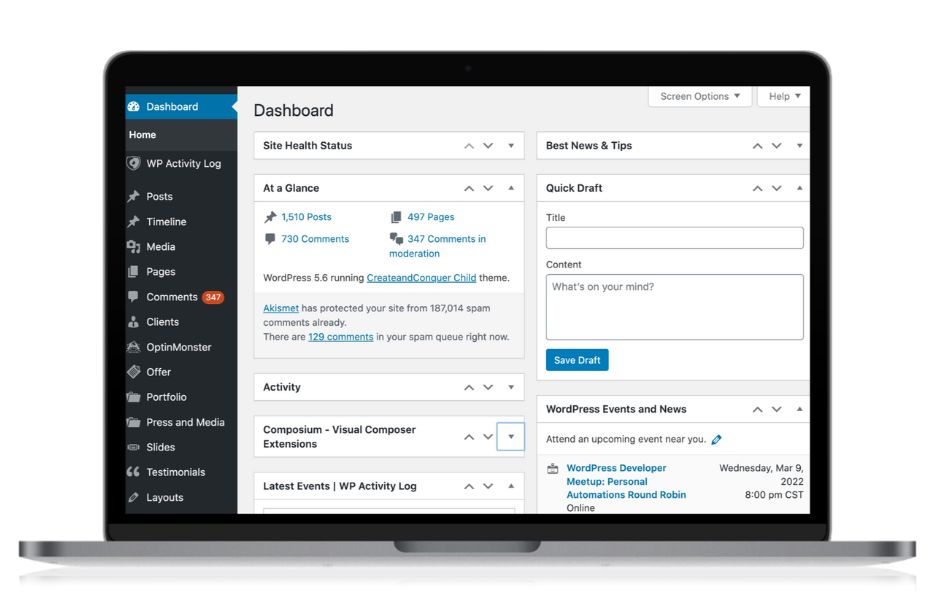
An example of the WordPress CMS.
CPA: Cost per Action
An online advertising metric that measures how much it costs an advertiser to attain a conversion action. CPA is calculated by dividing the total cost of the conversions by the total number of conversions.
CPC: Cost per Click
An online advertising metric that measures the cost of a single ad click in a pay-per-click (PPC) campaign. CPC is calculated by dividing the total cost of the clicks by the total number of clicks. See related: PPC
CPL: Cost per Lead
A metric that measures how much it costs for a marketing organization to acquire a new lead. Generally speaking, a lead is a prospect likely to make a purchase or become a customer in the future. This metric can be tracked for a single campaign or across all marketing channels, such as social media, email marketing, influencer marketing, events, etc. CPL is calculated by dividing your total marketing spend by the total number of new leads attained in a specific timeframe.
CR: Conversion Rate
A conversion rate measures the percentage of people taking a specific action on one of your web pages. Marketing goals determine these desired actions. Some examples include signing up for an email newsletter, filling out a contact form for a demo, or making a purchase on your site. A conversion rate is calculated by dividing your total number of conversions in a given timeframe by the total number of site (or page) visitors and multiplying by 100%.
CRM: Customer Relationship Management
An organized process a business uses to capture prospect and customer contact information and manage their interactions with the organization. With CRM software, you can track interactions across multiple channels to provide a holistic view of where an individual prospect or customer is on the buyer’s journey. Interactions may include purchases on your website, social media comments, emails to a sales representative, phone calls to customer service, etc. With this streamlined approach, sales efforts are better informed, team members can nurture leads more effectively, and targeted marketing is more efficient.
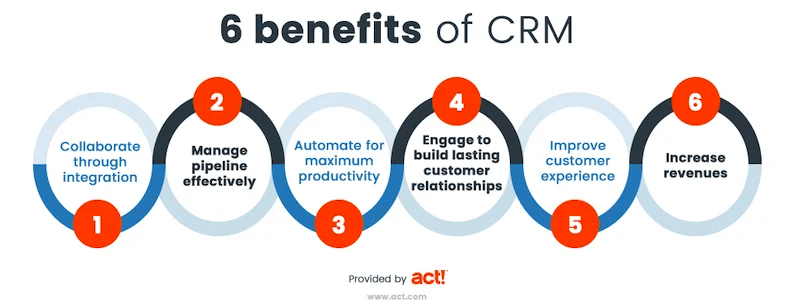
CTA: Call to Action
A marketing term that refers to the next step or desired action a marketer wants the prospect or customer to take. A CTA appears in many forms–text CTAs, CTA buttons, or verbal CTAs. They will often be found:
- On a landing page (encouraging an individual to complete a form)
- At the end of a blog post (to provide more resources)
- In an advertisement (e.g., “Learn more” or “Get started today!”)
- On a social media post (e.g., “Comment below with your insights”)
- On a call or video (e.g., “Thanks for joining our webinar. Please visit our website for more information.”)
CTR: Click-through Rate
A metric that measures the percentage of recipients who “click” on a specific link that takes them to the next step in your marketing campaign. CTR is calculated by dividing the total number of clicks on your ad, page, or email by the total number of impressions, which is the number of views on your ad, page, or email. (Find out what’s considered a good CTR.)
FAQ: Frequently Asked Questions
A page on a website dedicated to answering the most common questions your business receives. An FAQ page is a helpful resource for your customers and provides SEO benefits. Get inspired to create your FAQ page with these examples.

An example of a helpful FAQ page.
GA: Google Analytics
A service offered by Google that provides the basic tools and statistics needed to analyze your website traffic and digital marketing effectiveness.
GBP: Google Business Profile
Formerly Google My Business, or GMB, a Google Business Profile is a business listing that shows up on Google Maps and in Google Search. Businesses can claim and manage these listings to give searchers information such as hours of operation, address, phone number, products and services, and more.
H1, H2, H3, H4, H5, H6: Heading Elements (or Tags) in HTML
Headers are used for a web page or blog post to convey what the content will cover to the reader and search engines. The heading tags are hierarchical, with the H1 tag, or headline, being the first one on the page. The H1 is essentially the page’s title, and the subsequent tags (H2, H3, etc.) then break down the content into subtopics. Heading elements are an important factor in search engine ranking.
HREF: Hypertext Reference in HTML
An attribute that is used on a web page to hyperlink text to another section on the same page or a different URL.
IBL: Inbound Links
Also called backlinks, these refer to hyperlinks on other websites that direct people to your website. Explore how investing in an inbound marketing strategy will attract new customers to your small business.
KPI: Key Performance Indicator
The metrics a business tracks to determine how effectively it is performing towards its goals or objectives. Examples of KPIs in marketing may include marketing revenue attribution, marketing qualified leads (MQL), and landing page conversion rates.
LP: Landing Page
A standalone web page used in a marketing campaign as a location to convert visitors into leads. Learn the elements of high-converting landing pages.

An example of an effective landing page.
MAP: Marketing Automation Platform
A software solution that automates repetitive marketing activities and streamlines tasks such as email marketing, lead nurturing, audience segmentation, etc.
MoM: Month-over-Month
A timeframe used to compare the performance change from one month to the previous month.
MQL: Marketing Qualified Lead
A potential customer that the marketing team has vetted, meets the qualified lead criteria agreed upon by marketing and sales, and is worthy of being passed on to the sales team for lead nurturing.
NPS: Net Promoter Score
A metric used to measure customer experience and sentiment towards your brand. Learn more about the benefits and how to implement NPS for your small business.

An example of an NPS survey email.
OBL: Outbound Links
The opposite of inbound links, these refer to hyperlinks on your website that direct people to other websites.
POP: Point-of-Purchase
The location where a consumer considers making a purchase. In marketing, POP refers to the visuals and messaging a consumer sees that aids in their decision-making process (e.g., in-store display shelves, online advertisements, promotional flyers, etc.).
POS: Point-of-Sale
The location where the actual purchase and exchange of goods is made (online or in person, e.g., a cash register).
PPC: Pay-per-Click
An online advertising model where an advertiser pays a certain amount of money (flat-rate or bid-based) to the platform host (e.g., search engines, social media platforms) every time their ad is clicked.
PR: Public Relations
The strategic dissemination of information from a company to its public audience to manage and maintain its reputation.
QA: Quality Assurance
An internal review process to ensure all marketing and campaign materials meet the business requirements (e.g., free of errors, alignment with brand voice, correct hyperlinks, etc.).
QoQ: Quarter-over-Quarter
A timeframe used to compare the performance change from one quarter to the previous quarter.
QR Code: Quick Response Code
A scannable barcode (via mobile devices) on promotional materials to direct consumers to a website, contact form, and more. Some examples of marketing materials that may include a QR code include billboards, flyers, signage, business cards, TV advertisements, and social media posts.

An example of a QR code that links a blog post.
RFP: Request for Proposal
When a company needs an outside vendor or contractor to help with a project or service, it will send this document outlining the project or service requirements (e.g., price, timeframe, etc.) and request that these vendors provide a bid on the scope of work needed.
ROAS: Return on Ad Spend
A metric that measures how much revenue is earned for every dollar spent on advertising campaigns. Learn how to calculate ROAS.
ROI: Return on Investment
A metric that measures how much revenue is earned for every marketing activity across every channel. ROI provides an overview of each marketing tactic’s effectiveness and where a business should invest its time for a profitable return.
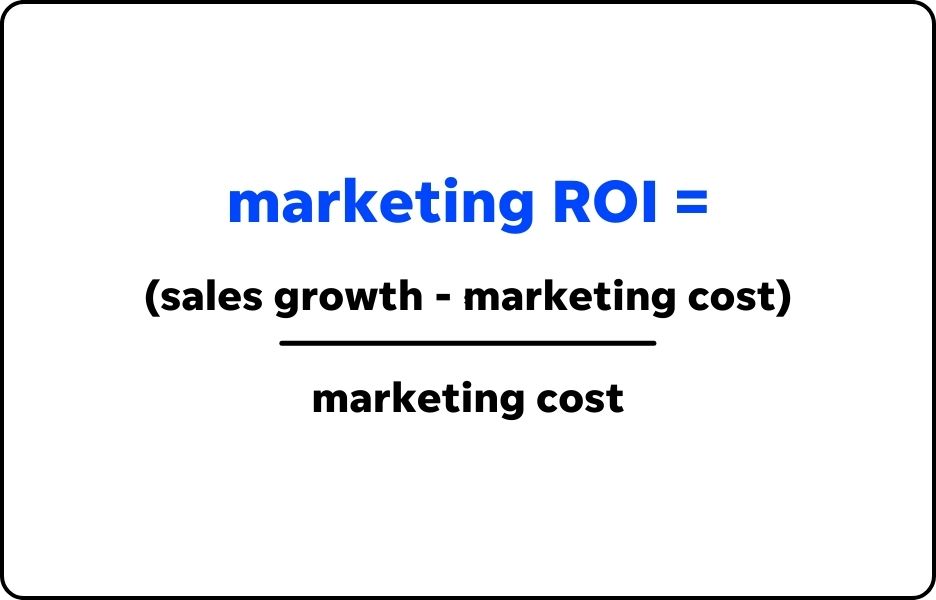
SaaS: Software as a Service
A software delivery model where providers host the application and provide access to users over the internet, allowing the business or user to avoid installing and maintaining complex software. Some examples of SaaS companies include Dropbox, Salesforce, WordStream, and Slack.
SEO: Search Engine Optimization
SEO is the process of enhancing your website to help it rank higher in organic (free!) search. A few methods to improve SEO include implementing targeted keywords, enhancing titles and metadata, and providing high-quality content that will help answer the end user’s questions. This process ensures you are meeting your customers where they are, often on search engines like Google and Bing.
SER: Search Engine Ranking
SER refers to a web page’s position on the search engine results page (SERP) for a relevant query. Find out why search visibility is such an essential factor for your business.
SERP: Search Engine Results Page
SERP is the list of results (web pages) that appear on a search engine after a user enters a query.
SLA: Service Level Agreement
A contract between two parties that outlines agreed-upon terms. In marketing, an SLA is often created between the sales and marketing teams to establish expectations around the responsibilities of each group. Notably, a sales and marketing SLA will often include parameters around what constitutes a qualified lead.
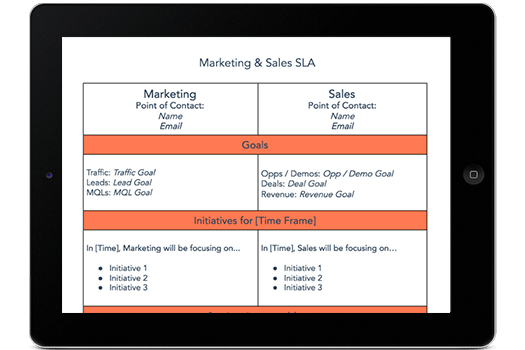
An example of a Marketing & Sales SLA.
SMB: Small-to-Medium-Sized Business
A term used to identify entities where owners are typically involved in decision-making. While subjective, small businesses usually have less than 100 employees, and midsize businesses have less than 1,000 employees.
SME: Subject Matter Expert
Also referred to as content matter experts, SMEs are highly skilled individuals who can share in-depth knowledge on a specific topic or industry. SMEs are often sought out in the product development process and also for content marketing.
SM: Social Media
Websites and applications where individuals and businesses create and share content and interact with other users. Some popular examples include Facebook, Twitter, LinkedIn, and TikTok.
SMM: Social Media Marketing
When a business uses social media platforms as a marketing channel to promote products and services, build brand awareness, interact with prospects and customers, and drive website traffic through organic and paid efforts.
SWOT: Strengths, Weaknesses, Opportunities, Threats
Often used in strategic marketing planning, SWOT analyzes the internal and external factors affecting an organization’s position in the competitive market.
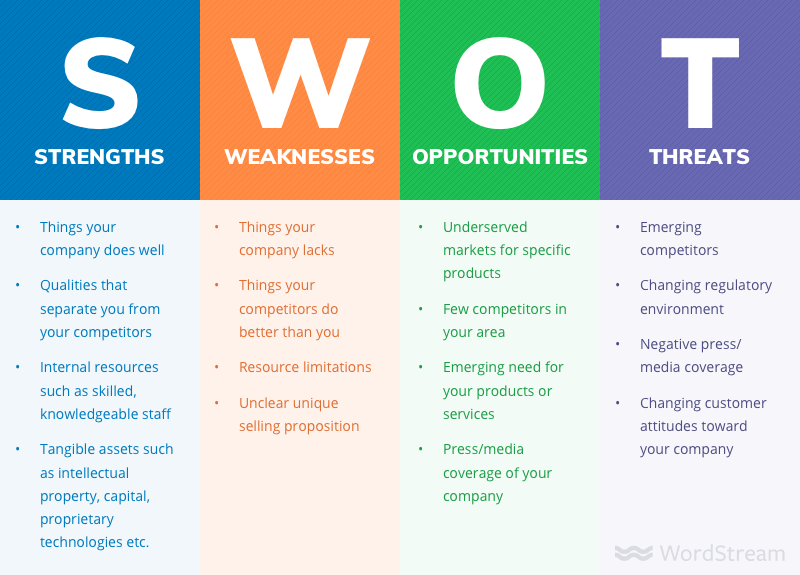
UGC: User-Generated Content
Just as it reads: UGC is content about your brand or service created and shared by individuals instead of businesses or brands. UGC takes many forms, including images, videos, reviews, blog posts, etc.
UI, UX: User Interface, User Experience
User interface refers to the visual elements and functionality your customer interacts with on your website, platform, or application. User experience refers to your customer’s holistic interaction with your digital product or service (and how they feel about it!).
UV: Unique Visitor
A metric that measures the number of distinct individuals who have visited your website or web pages in a specific period.
WOMM: Word of Mouth Marketing
When consumers are so delighted with a brand’s product or service, they talk about it with other consumers (free marketing!). Learn more about word-of-mouth marketing here.
YoY: Year-over-Year
A timeframe used to compare the performance change from one year to the previous year.
Master marketing acronyms and abbreviations in 2024
So, there you have it: 53 of the most commonly used marketing acronyms and abbreviations to enhance your communication with colleagues and other marketing professionals.
Ready to test your newfound knowledge? Here’s a glimpse at a few of the questions and remarks you’ll now be confident to respond to:
- Your boss asks: “Can you send me the MoM MQLs for the KPI report?”
- Your SMM manager excitedly tells you: “The ROI for the UGC TikTok campaign is exceeding our expectations!”
- Your editor inquires: “Do we have an SME with SEO experience available to help?”
With new marketing trends and technology just around the corner, you may be wondering how you can stay up to date. Simply put, keep learning as you go!:
- Follow the trends being discussed in your professional circles or on social platforms like LinkedIn
- Read the latest content from marketing thought leaders (like posts from on blog!)
- Don’t be afraid to ask questions
Finally, we’ve rounded up 50 acronyms for you in this handy cheat sheet:







